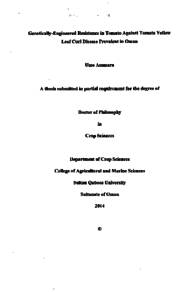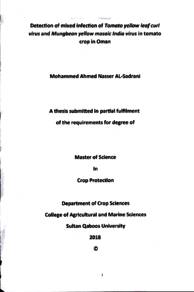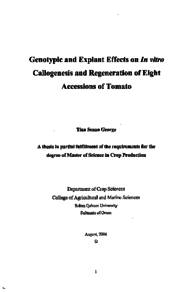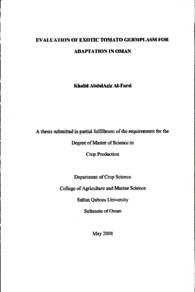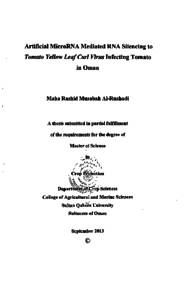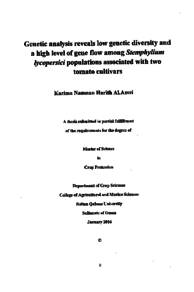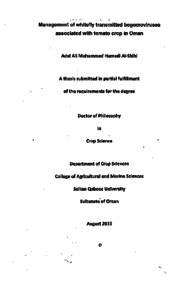وثيقة
Genetically-engineered resistance in tomato against tomato yellow leaf curl disease prevalent in Oman
الناشر
Sultan Qaboos University
ميلادي
2014
اللغة
الأنجليزية
الموضوع
الملخص الإنجليزي
Tomato yellow leaf curl virus (TYLCV) is the most prevalent viral pathogen responsible for heavy yield losses of tomato in Oman. This virus belongs to the genus Begomovirus of the family Geminiviridae. Despite all efforts to manage TYLCV, there is no natural source of resistance available that can provide 100% resistance against it. This study was carried out to develop broad-spectrum resistance against begomoviruses infecting tomato plants using pathogen-derived resistance.
Firstly, a reliable tomato transformation protocol was established by optimizing the efficiency of Agrobacterium-mediated tomato transformation. Cotyledon and epicotyl parts from susceptible tomato cultivars (cvt) Moneymaker, Pusa ruby and Jinan were used as explants and co-cultivated with Agrobacterium tumefaciens strain AGL1 harboring different genes. The effects of putrescine, vitamins, explants and growth regulators on plant transformation and regeneration were studied. Conditions were optimized to achieve transformation efficiency up to 49.2% with cotyledons used as explants. After that three genes (Repsyn130, CPsyn and hpRNAI) were cloned and transformed independently in tomato cultivar (cvt) Pusa ruby to test their individual ability to offer resistance to Tomato yellow leaf curl virus-Oman (TYLCV-OM) and Tomato leaf curl betasatellite-Oman (TOLCB-OM). Homology-dependent gene silencing of the transgene was avoided using codons highly expressed in tomato. 1) Gene encoded a truncated Rep protein comprising of 130 amino acids from N-terminal of Rep (Repsyn130). The gene was transformed in cvt. Pusa ruby plants and T, transgenic plants were co-infiltrated with TYLCV-OM and TYLCV-OM/ TOLCB-OM. Seven out of 9 transgenic lines were found to be resistant to the begomovirus-betasatellite complex. 2) Hairpin construct targeting four different regions of TYLCV-OM including pre-coat protein (V2), overlapping region of coat protein (CP), replication associated protein (Rep) and part of the conserved intergenic region (IR). Nine transgenic lines expressing hpRNAi construct were challenged with TYLCV-OM and TYLCV-OM/TOLCB-OM. Transgenic plants inoculated with TYLCV-OM did not develop symptoms even 60 days post-inoculation (60 dpi) and showed 80-100% resistance while transgenic lines inoculated with TYLCV-OM/TOLCB-OM showed 70-80% resistance. 3) Synthetic codon-optimized CP (CPsyn) of TYLCV-OM which was expressed in transgenic tomato to avoid gene silencing of the transgene upon virus infection. Plants of 3 transgenic lines out of 7 showed resistance against TYLCV-OM and TYLCV-OM/TOLCB-OM. Southern hybridization and real time quantitative PCR data showed that transgenic plants accumulated low levels of viral DNA. 4) Finally, a single construct was developed by combining Repsyn130, RNAi and CPsyn under their independent promoter/terminator to avoid promoter silencing. A total of 24 positive transgenic lines were produced and evaluated for their resistance against TYLCV-OM, Tomato leaf curl Albatinah virus (TOLCABV) alone and with ToLCB-OM. Results indicated that 100% resistance level was achieved against TYLCV-OM and TOLCABV when all genes were assembled in a single construct.
This study shows that the resistance response of transgenic plants against TYLCV-OM and TYLCV-OM/TOLCB can be improved by combining genes for resistance in a single construct. The developed multi construct transgenic lines can be further evaluated for their resistance potential against diverse heterologous geminiviruses reported from Oman.
المجموعة
URL المصدر
الملخص العربي
يعتبر فيروس مرض تجعد واصفرار اوراق الطماطم الأكثر انتشارا ويتسبب في خسائر كبيرة في الطماطم في سلطنة عمان. ينتمي هذا الفيروس الى فصيلة البيجوموفيروس و عائلة الجيمينفيريديا۔ وبالرغم من الطرق المستخدمة لعلاج هذا الفيروس، إلا أنه لا توجد أصناف طماطم بها مقاومة كلية الفيروس. كان الهدف الرئيسي من هذه الدراسة تطوير مقاومة واسعة النطاق الفيروسات البيجوموفيروس التي تصيب الطماطم وذلك بالاعتماد على المقاومة المستنبطة من الفيروس.
بداية، تم تطوير وسيلة لنقل الجينات الطماطم بواسطة بكتيريا (Agrobacterium) وذلك عن طريق ضبط الوسط الغذائي. تم استخدام أجزاء خضرية صغيرة من بعض النباتات الحساسة مثل المني ميكر بوزا روبي والجنان حيث تم تطعيمها ببكتيريا (Agrobacterium tumefaciens) ناقلة للجينات، ومن ثم تم دراسة تأثير البيتراسين والفيتامينات والأجزاء الخضرية والهرمونات على عملية النقل والنمو. أظهرت النتائج تحقيق كفاءة نمو بنسبة 49% باستخدام الخضيرات الصغيرة بعد ذلك تم اختبار قدرة ثلاث جينات مصنعة على إنتاج مقاومة الفيروس في الطماطم (صنف البوزا روبي) بشكل انفرادي. الجين الأول يختص بإنتاج بروتين الريب المكون من 130 حمض نووي حيث تم نقل الجين إلى صنف البوزا روبي. تم تطعيم نباتات الجيل الأول بفيروس تجعد واصفرار اوراق الطماطم والفيروس المصاحب له. وجد أن 7 نباتات من أصل 9 كانت مقاومة كلا الفيروسين. الجين الثاني استهدف اربعة اجزاء للفيروس، اثنان مختصان بالغلاف البروتيني للفيروس وآخرين مختصين بالبروتين المسئول عن التكاثر وجزء من المنطقة الوسطية للفيروس. تم تطعيم 9 نباتات تحتوي على الجين الصناعي بالفيروس وايضا الفيروس المصاحب له، حيث وجد أن النباتات المعدلة وراثيا والتي طعمت بالفيروس أظهرت مقاومة بنسبة 80-100%، في حين أظهرت النباتات التي طعمت كلا الفيروسين مقاومة تراوحت ما بين 70-80 بالمئة. الجين الصناعي الثالث اختص بالغلاف البروتيني للفيروس حيث تم تغيير السلسلة الجينية من دون التأثير على البروتين المنتج وذلك لمنع تثبيط الجين، حيث أظهرت النتائج أن 3 نباتات معدلة وراثيا من أصل 7 أظهروا مقاومة جيدة ضد الفيروسين معا، وعند قياس معدل الفيروس باستخدام Southernhybridization , RT - PCR أظهرت النتائج كميات قليلة من الحمض النووي في النباتات المعدلة وراثيا. وفي الجزء الأخير من الدراسة تم تطوير مركب جيني يضم الجينات الثلاثة معا ( Repsyn130و. CPsyn و hpRNAi) عن طريق تنظيم عملية النسخ بشكل مستقل لكل جين وذلك لمنع تثبيط الجينات معا. تم إنتاج 24 نباتا معدلا وراثيا ومن ثم تم تطعيم النباتات بفيروس مرض تجعد واصفرار اوراق الطماطم (سلالة عمان وسلالة الباطنة) وأيضا الفيروس المصاحب. أظهرت النتائج مقاومة بنسبة 100% للفيروسات باستخدام الجين المركب.
تشير نتائج هذه الدراسة إلى أن استخدام مركب يحتوي على عدة جينات يمكن أن يزيد من مقاومة الطماطم للفيروسات. ننصح بتقييم مقاومة النباتات المعدلة وراثيا ضد فيروسات أخرى من عائلة البيجوموفيروسات خصوصا تلك التي تنتشر في سلطنة عمان.
بداية، تم تطوير وسيلة لنقل الجينات الطماطم بواسطة بكتيريا (Agrobacterium) وذلك عن طريق ضبط الوسط الغذائي. تم استخدام أجزاء خضرية صغيرة من بعض النباتات الحساسة مثل المني ميكر بوزا روبي والجنان حيث تم تطعيمها ببكتيريا (Agrobacterium tumefaciens) ناقلة للجينات، ومن ثم تم دراسة تأثير البيتراسين والفيتامينات والأجزاء الخضرية والهرمونات على عملية النقل والنمو. أظهرت النتائج تحقيق كفاءة نمو بنسبة 49% باستخدام الخضيرات الصغيرة بعد ذلك تم اختبار قدرة ثلاث جينات مصنعة على إنتاج مقاومة الفيروس في الطماطم (صنف البوزا روبي) بشكل انفرادي. الجين الأول يختص بإنتاج بروتين الريب المكون من 130 حمض نووي حيث تم نقل الجين إلى صنف البوزا روبي. تم تطعيم نباتات الجيل الأول بفيروس تجعد واصفرار اوراق الطماطم والفيروس المصاحب له. وجد أن 7 نباتات من أصل 9 كانت مقاومة كلا الفيروسين. الجين الثاني استهدف اربعة اجزاء للفيروس، اثنان مختصان بالغلاف البروتيني للفيروس وآخرين مختصين بالبروتين المسئول عن التكاثر وجزء من المنطقة الوسطية للفيروس. تم تطعيم 9 نباتات تحتوي على الجين الصناعي بالفيروس وايضا الفيروس المصاحب له، حيث وجد أن النباتات المعدلة وراثيا والتي طعمت بالفيروس أظهرت مقاومة بنسبة 80-100%، في حين أظهرت النباتات التي طعمت كلا الفيروسين مقاومة تراوحت ما بين 70-80 بالمئة. الجين الصناعي الثالث اختص بالغلاف البروتيني للفيروس حيث تم تغيير السلسلة الجينية من دون التأثير على البروتين المنتج وذلك لمنع تثبيط الجين، حيث أظهرت النتائج أن 3 نباتات معدلة وراثيا من أصل 7 أظهروا مقاومة جيدة ضد الفيروسين معا، وعند قياس معدل الفيروس باستخدام Southernhybridization , RT - PCR أظهرت النتائج كميات قليلة من الحمض النووي في النباتات المعدلة وراثيا. وفي الجزء الأخير من الدراسة تم تطوير مركب جيني يضم الجينات الثلاثة معا ( Repsyn130و. CPsyn و hpRNAi) عن طريق تنظيم عملية النسخ بشكل مستقل لكل جين وذلك لمنع تثبيط الجينات معا. تم إنتاج 24 نباتا معدلا وراثيا ومن ثم تم تطعيم النباتات بفيروس مرض تجعد واصفرار اوراق الطماطم (سلالة عمان وسلالة الباطنة) وأيضا الفيروس المصاحب. أظهرت النتائج مقاومة بنسبة 100% للفيروسات باستخدام الجين المركب.
تشير نتائج هذه الدراسة إلى أن استخدام مركب يحتوي على عدة جينات يمكن أن يزيد من مقاومة الطماطم للفيروسات. ننصح بتقييم مقاومة النباتات المعدلة وراثيا ضد فيروسات أخرى من عائلة البيجوموفيروسات خصوصا تلك التي تنتشر في سلطنة عمان.
قالب العنصر
الرسائل والأطروحات الجامعية

